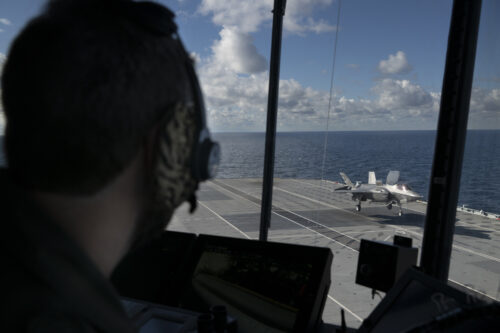It was a crisp October morning when the mighty HMS Prince of Wales, Britain’s largest and most advanced aircraft carrier, sliced through the waters of the Western Atlantic. Aboard the massive warship, anticipation buzzed through the crew and the test team. The goal: to execute the very first Shipborne Rolling Vertical Landing (SRVL) with the formidable F-35B Lightning II fighter jet.

As the ship cruised through the waves, a sense of excitement blended with tension. The SRVL was no ordinary landing; it was a complex combination of vertical and conventional landing, allowing the aircraft to approach and land at significantly reduced speeds and distances compared to traditional methods.
The F-35B was a marvel in aviation history. A 5th generation strike aircraft capable of Short Takeoff and Vertical Landing (STOVL), it promised unmatched versatility and lethality. Yet, the SRVL was not only about showcasing this advanced jet’s capabilities; it was about expanding the envelope of what was possible in naval aviation.
The secret of the SRVL was in its name: “rolling.” Unlike the traditional Vertical/Short Takeoff and Landing (V/STOL) aircraft, which either landed vertically or on a conventional runway, the SRVL combined the two approaches. It harnessed downward jet thrust from the F-35B’s engine to hover while maintaining sufficient forward velocity to generate wing lift. This unique approach allowed for a rolling landing on the deck of the HMS Prince of Wales, all without needing catapults and arrestor wires, which were typical features on other aircraft carriers.
As the British and American teams watched from the carrier’s deck, the F-35B approached gracefully, its engine roaring and nozzles tilted downward. In the cockpit, Marine Maj. Paul Gucwa concentrated, guiding the aircraft with expert precision.
The jet descended with a gentle grace, slowing down just before touchdown. It was a breathtaking moment as the wheels met the deck, and the aircraft came to a controlled stop, its braking system assisted by the innovative disc brakes integrated into the landing gear. This successful SRVL showcased the enhanced landing capabilities of the F-35B and the groundbreaking design of the HMS Prince of Wales, marking a historic moment in naval aviation.
HMS Prince of Wales, the second of the Royal Navy’s Queen Elizabeth-class aircraft carriers, had been meticulously designed for this kind of naval innovation. Unlike carriers with catapults and arrestor wires, it was intended to operate Short Takeoff and Vertical Landing (STOVL) aircraft like the F-35B. Capable of carrying up to 48 of these stealthy multirole fighters and other aircraft, it was a formidable vessel, designed to bolster the Royal Navy’s capabilities on the high seas.
The ship had an impressive history, being formally commissioned into the Royal Navy in December 2019. Its arrival marked the beginning of a new era for British naval power projection. And now, with the successful SRVL completed, it was pushing the boundaries of what modern aircraft carriers could achieve.
The SRVL had not just made naval aviation safer; it had opened up a world of possibilities for the F-35B. This joint endeavor by the British and American teams signified a promising future, where aircraft could land and take off from the deck of HMS Prince of Wales with increased efficiency, expanded payload capacity, and extended operational life.
As Maj. Paul Gucwa taxied the F-35B to the deck’s edge, he couldn’t help but smile. The successful SRVL wasn’t just a remarkable feat for him; it was a defining moment in the annals of naval aviation history. And on the impressive deck of the HMS Prince of Wales, this achievement was celebrated not just by one nation but by all who understood the significance of what they had just witnessed.
For more information, hit the Source below